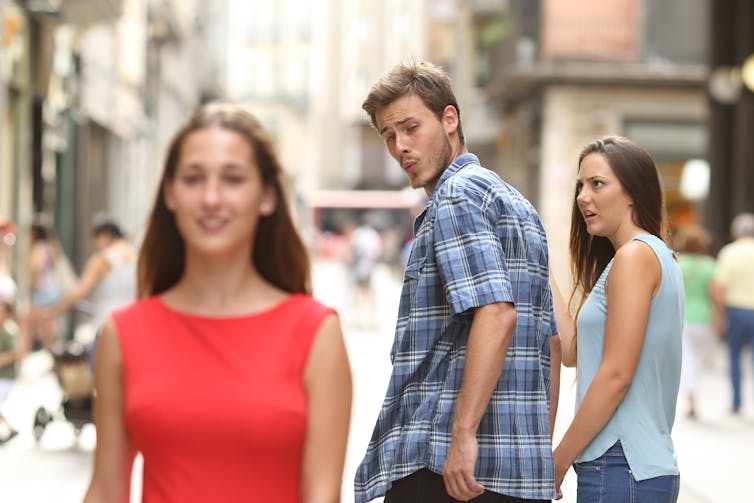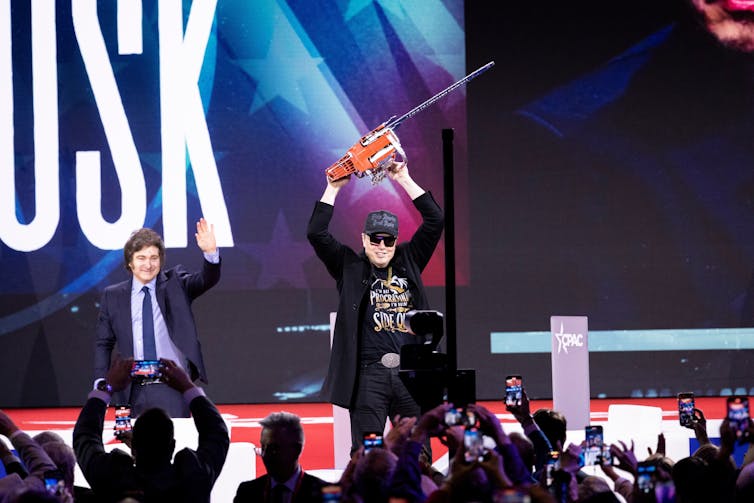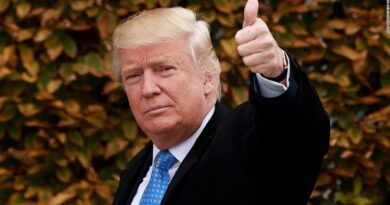How memes spread conspiracy theories – and what to consider before sharing one
“I am become meme,” declared Elon Musk at the 2025 Conservative Political Action Conference, just after hoisting a chainsaw – a gift from Argentina’s president, Javier Milei – above his head. The tech billionaire and head of President Donald Trump’s Department of Government Efficiency (Doge) was correct. Within hours, images of the moment had spread across social media, spawning countless edits, humorous remixes and sharp commentary.
This moment was more than just a spectacle. It exemplified how, in a digital age where the battle for attention is paramount, memes are a key part of political conversation. While memes might seem purely entertaining, my research confirms their influence goes deeper, shaping and intensifying political views and attitudes in significant ways.
The power of memes lies in their ability to distil complex ideas into instantly recognisable forms. They rely on established visual templates, which eliminate the need for lengthy explanations and communicate to the viewer how they should think about the topic of the meme.
Distracted boyfriend (in which a man looks over his shoulder at an attractive woman to the annoyance of his girlfriend) is a perfect example. It succinctly communicates the universal experience of being tempted by one option while neglecting another – applicable to everything from consumer preferences to political allegiances.

Antonio Guillem/Shutterstock
However, this simplification can quickly become problematic when memes portray distorted or misleading views of reality.
Harmful stereotypes, misinformation and conspiracy theories have all found their way into meme format. Memes can transmit dangerous ideas, cloaked in humour that makes them more palatable.
Conspiracy theories and memes
Conspiracy theories prove especially adaptable to the meme format. Their narratives rely heavily on simple “us v them” portrayals of enlightened truth-seekers standing up against powerful conspirators and an unaware or passive public.
My analysis of hundreds of memes from COVID conspiracy communities on Reddit revealed a striking pattern: the same templates appeared repeatedly, reinforcing this simplistic but powerful dichotomy.
Many memes portrayed conspiracy believers as enlightened truth-seekers. “Lisa Simpson’s Presentation”, showing the comic cartoon character confidently presenting to an audience, was commonly used to share claims that challenged mainstream narratives about science, medicine and the government.
Other memes portrayed authorities as powerful manipulators. “Daily Struggle/Two Buttons”, showing a character sweating over which of two contradictory buttons to press, was commonly used to suggest that health officials and media outlets deliberately switched between opposing vaccination narratives when convenient.
Most prevalent were portrayals of an unaware or passive public, with “NPC Wojak” – a grey, expressionless figure named after video game “non-playable characters” – presenting a visual shorthand. Those who followed public health advice and mandates were portrayed as mindless automatons, incapable of critical thinking or independent judgment.
These kinds of meme did not just reflect existing beliefs – they actively shaped and intensified them. Through repeated exposure, these ideas became normalised and accepted as truth. Memes created a feedback loop where existing suspicions were validated, amplified and spread to others – with real-world effects.
During the pandemic, conspiracy theories that were shared widely via memes led to real-world action, from vaccine refusal to violent global protests against public health mandates.
The accessible humour of memes served as an entry point, attracting audiences who might have initially engaged with the content as “just jokes”, but subsequently adopted increasingly extreme perspectives.

Joshua Sukoff/Shutterstock
Think before sharing
Given their power to influence political views and attitudes and to spread misinformation, it is important to think critically before sharing a meme. Here are some key pointers:
1. Think about the hidden message
Memes often use humour or exaggeration, but consider the underlying message. Is it simplifying a complex issue or distorting reality? Remember that memes can disguise the extremity of viewpoints, making them appear more familiar and acceptable.
2. Identify who’s behind it
Consider the source or origin of the meme. Who might benefit from spreading this message? Is it associated with extreme or conspiratorial communities? If you are unsure, a quick check on Know Your Meme or a reverse image search can provide helpful context.
3. Check for implicit assumptions
Memes often operate through implicit assumptions about society, expertise and evidence that go unstated. Ask yourself: what core beliefs must someone accept for this meme to make sense? For example, a meme mocking people who “trust the science” might contain the unstated assumption that scientific consensus is merely opinion, rather than evidence-based conclusion.
4. Think about emotional manipulation
Memes rely heavily on emotional reactions – often humour, anger, or outrage – to encourage rapid sharing. Before clicking “share”, reflect on whether you’re being manipulated emotionally into spreading an idea you wouldn’t openly support.
5. Consider potential harm
Ask yourself if sharing the meme could contribute to harm, whether by reinforcing harmful stereotypes, or spreading misinformation or conspiracy theories. Humour can disguise the impact of these ideas, making them seem acceptable when they aren’t.
6. Remember that context matters
A meme may seem funny or insightful on its own – but within wider conversations, it can take on new meanings. Consider how it might be interpreted alongside other messages circulating in similar spaces. Could it be contributing to a pattern of misinformation, division or trivialisation?
Ultimately, becoming mindful of the memes we share isn’t about losing a sense of humour, it’s about gaining control over the ideas we help circulate. Before you click share, take a second to think – every meme you spread can affect how people see the world.


